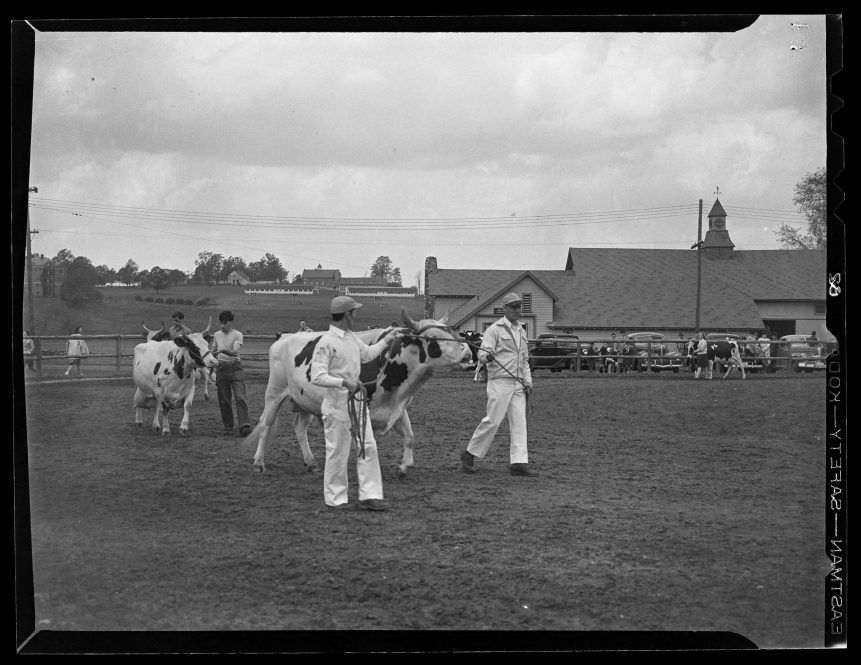Old samples can help shed new light on the pressing issue of antibiotic resistance

An agriculture show at UConn in 1945, during the period the dairy samples were collected (Department of Archives & Special Collections/UConn Library)
Sometime in the 1940s or so, someone in what is now the Department of Pathobiology and Veterinary Science got a lyophilizer, a piece of equipment that freeze-dries samples, says Director of the Connecticut Veterinary Medical Diagnostic Laboratory (CVMDL) Dr. Guillermo Risatti. Risatti explains that at that time, the microbiology lab was very active in testing milk for the dairy farms in the region. With an exciting new piece of equipment, it seems they started lyophilizing hundreds of samples.
The samples have been in storage ever since. Beyond the scant details that these are milk samples containing Streptococcus bacteria from the 1940s, Risatti explains that he and his colleagues – CVMDL Research Associate Dr. Zeinab Helal, Ji-Yeon Hyeon (now at College of Veterinary Medicine, Konkuk University, Seoul, Republic of Korea), and Dong-Hun Lee (also now at College of Veterinary Medicine, Konkuk University, Seoul, Republic of Korea) – were interested in exploring their microbial history.
Risatti says that over the years, the data was lost, so researchers don't have precise details of the provenance of the samples. But knowing a bit of history about the department, they can deduce some information.
"We believe that most of them came from Connecticut or perhaps from cases from the region, but we cannot say which parts," Risatti says. "Most likely, this lab provided a testing service to locals, as this was mainly a pathology lab. Now it's more like a diagnostic lab, and we receive samples from all over the region, including New York and New Jersey."
Learning about what these historical samples hold could help with research in unexpected ways, but the first step is piecing together the lost details. To do this, Risatti explains that the team established a workflow using standard techniques to streamline processes to analyze the visual characteristics, called phenotype, and to analyze their genotype with genomic sequencing.
Different species of Streptococcus use different strategies to inflict disease in the organisms they infect. These virulence factors are used to differentiate one species of Streptococcus from another and are one way to distinguish samples through phenotypic analysis. Another phenotypic analysis includes testing bacteria for their susceptibility to antibiotics.
The researchers started with 50 samples collected from 1941 to 1947, and they found that the samples contained seven different Streptococcus species, including two subspecies of S. dysgalactiae. Interestingly, the researchers found some of the samples were resistant to the antibiotic tetracycline and did not carry antibiotic resistance genes typically seen in today's antibiotic-resistant bacterial strains. Since these samples were collected prior to the antibiotic era, the results add to a growing body of literature showing that antibiotic resistance occurred naturally before humans discovered and began to use antibiotics.
"Antibiotic resistance is a very big area of research, and it has been for many years," says Risatti. "We did not go any further with our analysis because we don't have the tools here, but we hope to bring this information to the public. I think it could be the jumpstart for somebody to study further."
Risatti explains the hope is to partner with large agencies like the CDC and the Department of Public Health to help bolster antibiotic resistance research.
In developing the workflow, Risatti also praised the work of students Jillian Baron '24 (CAHNR) and Patricia Arceta '24 (CAHNR):
"This is a good platform for undergraduate students to gain experience and publish their findings. I am surprised by how eager these young people are. I am glad we can provide the space to do these things."
With an eye toward the future, Risatti is excited about potential future collaborations: "I hope that people can see a link between what we do at CVMDL and human health."






